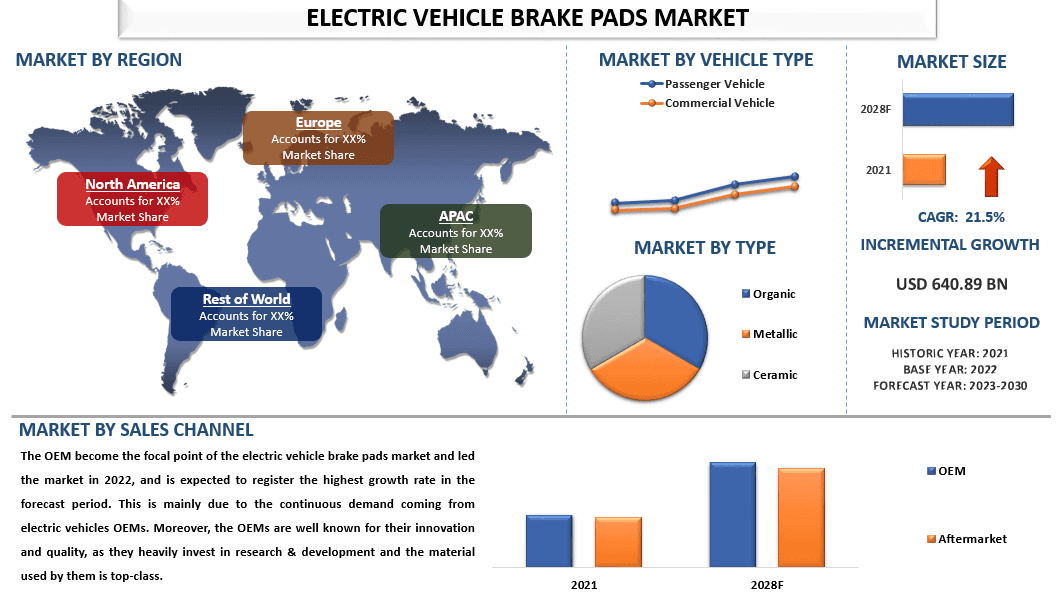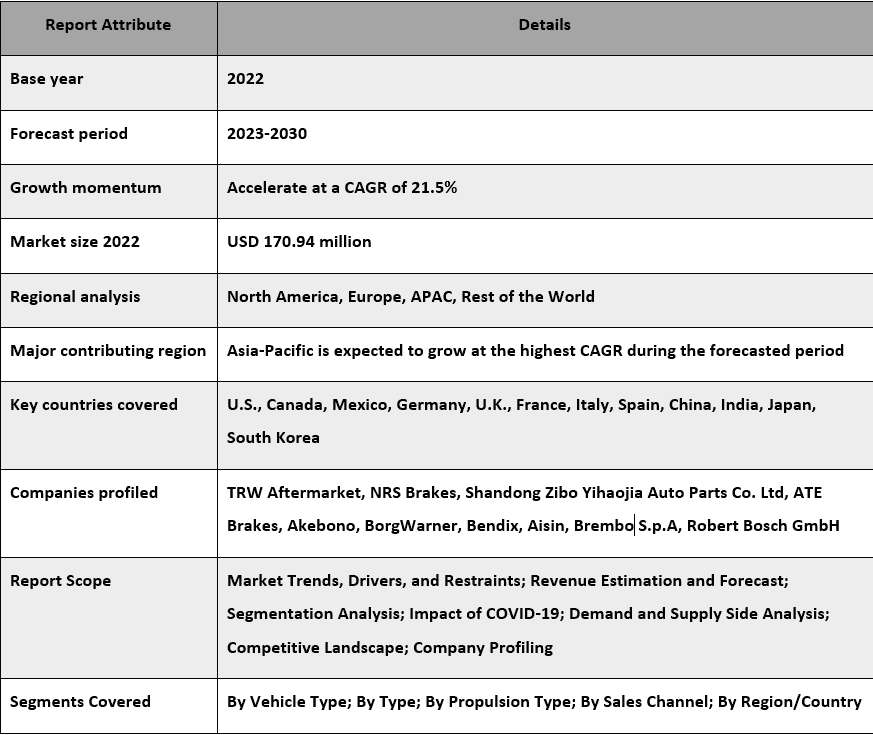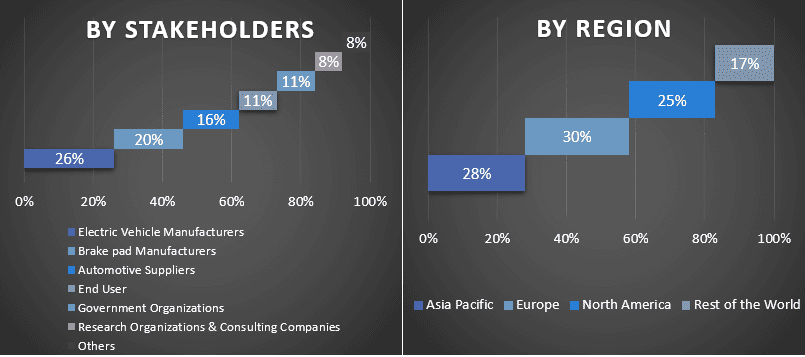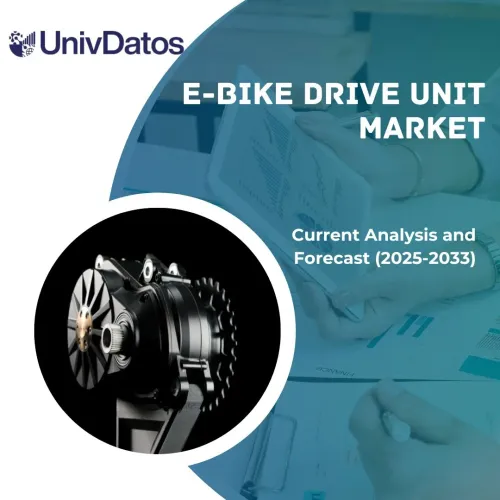- Home
- Chi siamo
- Settore
- Servizi
- Lettura
- Contattaci
Mercato delle pastiglie freno per veicoli elettrici: analisi attuale e previsioni (2023-2030)
Enfasi su Tipo di Prodotto (Lucidatura e Ceratura, Pulizia e Lavaggio, Sigillante e Rivestimento); Tipo di Auto (Berlina, Sedan, SUV, Veicoli Utilitari); Applicazione (Interni, Esterni); Canale di Distribuzione (Online, Offline); e Regione/Paese

Si prevede che il mercato delle pastiglie dei freni per veicoli elettrici crescerà con un forte CAGR di circa il 21,5% durante il periodo di previsione, grazie alle rigide normative governative per raggiungere emissioni nette pari a zero e ridurre l'inquinamento a livello globale. La crescente urbanizzazione della popolazione nella regione, poiché India e Cina coprono quasi il 36% della popolazione mondiale. Inoltre, paesi come Cina, India e Indonesia hanno una vasta popolazione attiva che si reca negli uffici e nelle fabbriche alla ricerca di trasporti quotidiani, il che ha fatto aumentare la domanda di mercato dei veicoli elettrici nella regione. Inoltre, i governi della regione come l'India e la Cina promuovono fortemente le emissioni nette pari a zero poiché le città della regione sono fortemente inquinate a causa dell'aumento del numero di veicoli su strada. Ad esempio, a marzo 2022, secondo il rapporto pubblicato da IQAir, una società svizzera ha riferito che l'India è il quinto paese più inquinato tra 117 paesi, secondo le raccomandazioni dell'OMS i livelli medi di PM2,5 non dovrebbero superare i 5 microgrammi per metro cubo, raggiungendo 58,1 microgrammi per metro cubo (µg/m3) nel 2021 in India. Inoltre, il paese ha 63 città indiane tra i 100 luoghi più inquinati della Terra. Pertanto, per controllare il livello di inquinamento, l'approccio del governo è quello di promuovere l'adozione di veicoli elettrici fornendo vari incentivi e sconti per l'acquisto di veicoli elettrici. Pertanto, la domanda di veicoli elettrici è aumentata rapidamente negli ultimi due anni, quindi la domanda di pastiglie dei freni per veicoli elettrici è aumentata e si prevede che crescerà a un ritmo elevato nel periodo di previsione.
Alcuni dei principali attori che operano sul mercato includono ZF Friedrichshafen AG (TRW Aftermarket), NRS Brakes, Shandong Zibo Yihaojia Auto Parts Co. Ltd, ATE Brakes, Akebono, BorgWarner, Bendix, Aisin, Brembo S.p.A, Robert Bosch GmbH. Diverse fusioni e acquisizioni, insieme a partnership, sono state intraprese da questi attori per agevolare i clienti con prodotti/tecnologie hi-tech e innovative.
Approfondimenti presentati nel rapporto
"Tra i tipi di veicoli, il segmento dei veicoli passeggeri ha rappresentato un segmento di punta del mercato nel 2022"
Sulla base del tipo di veicolo, il mercato è suddiviso in veicoli passeggeri e veicoli commerciali. Il segmento passeggeri ha guidato il mercato e si prevede che guiderà nel periodo di previsione in termini di contributo di entrate al mercato globale. I principali fattori che contribuiscono alla crescita dei segmenti sono dovuti all'adozione di veicoli passeggeri per la mobilità personale e ai servizi di ride-hailing e alla necessità di sostituire le pastiglie dei freni nel tempo. Inoltre, le persistenti pratiche governative per raggiungere gli obiettivi di emissioni nette pari a zero di vari paesi in tutto il mondo hanno soddisfatto la domanda di adozione di veicoli elettrici. Molti consumatori ora scelgono i veicoli elettrici rispetto ai veicoli convenzionali a benzina a causa della diminuzione delle emissioni, della riduzione delle spese di gestione e della sostenibilità complessiva. Inoltre, i miglioramenti nella tecnologia delle batterie hanno reso i veicoli elettrici più realistici e affidabili per l'uso ordinario
"Tra i tipi, il segmento della ceramica ha detenuto la quota di mercato significativa nel 2022"
Sulla base del tipo, il mercato è suddiviso in organico, metallico e ceramico. Tra questi, il segmento della ceramica deteneva una quota significativa del mercato nel 2022. Ciò è dovuto principalmente alla crescente domanda di veicoli da tutto il mondo a causa dell'aumento del reddito disponibile e alla necessità di spostamenti quotidiani. I materiali ceramici hanno proprietà uniche come elevata resistenza, durezza, resistenza chimica e stabilità termica. Una delle principali richieste di veicoli elettrici proviene dal settore del ride-sharing, spingendo così il segmento automobilistico nel mercato delle pastiglie dei freni per veicoli elettrici. Ad esempio, a febbraio 2023, Uber Technologies Inc, una società di ride-sharing con presenza in tutto il mondo, ha firmato un Memorandum of Understanding (MoU) con Tata Motors per portare 25.000 veicoli elettrici (EV) sulla piattaforma Uber in India.
"Tra i tipi di propulsione, il segmento dei veicoli elettrici a batteria ha detenuto la quota maggiore di quota di mercato nel 2022"
Sulla base del tipo di propulsione, il mercato è suddiviso in veicoli elettrici a batteria, veicoli ibridi elettrici e veicoli elettrici ibridi plug-in. Tra questi, il segmento dei veicoli elettrici a batteria deteneva una quota significativa del mercato nel 2022. Ciò è dovuto principalmente alla crescente domanda di veicoli elettrici a batteria da tutto il mondo a causa dell'aumento del reddito disponibile e alla necessità di spostamenti quotidiani. Un veicolo elettrico a batteria, o BEV, è un tipo di veicolo che funziona esclusivamente con energia elettrica. I BEV utilizzano solo un motore elettrico alimentato da batterie ricaricabili, queste batterie sono solitamente costituite da celle agli ioni di litio e possono essere caricate collegando il veicolo a una fonte di alimentazione elettrica. Ad esempio, a febbraio 2023, Toyota sta finalmente accelerando lo sviluppo di BEV in particolare, BEV di nuova generazione per il marchio Lexus entro il 2026, e a gennaio 2023, Maruti ha annunciato il lancio di sei veicoli elettrici a batteria in India entro il 2030.
"L'Asia Pacifico ha dominato il mercato delle pastiglie dei freni per veicoli elettrici nel 2022"
Si prevede che la regione Asia Pacifico sarà la regione dominante nel periodo di previsione in quanto la regione ha il più alto numero di produttori automobilistici e unità di produzione che soddisfano la domanda di pastiglie dei freni per veicoli elettrici. I principali fattori attribuiti alla crescita del mercato sono la crescente urbanizzazione della popolazione nella regione, poiché India e Cina coprono quasi il 36% della popolazione mondiale. Con il cambiamento di paradigma della crescita della popolazione nelle città della regione alla ricerca di migliori opportunità di lavoro e standard di vita, la domanda di mobilità personale è aumentata negli ultimi anni e i clienti stanno adottando i veicoli elettrici grazie agli sconti offerti dai governi e ai minori costi di manutenzione dei veicoli elettrici che contribuiscono alla crescita delle pastiglie dei freni per veicoli elettrici. Ad esempio, secondo l'Agenzia Internazionale dell'Energia (IEA), in Cina sono stati venduti più veicoli nel 2021 (3,3 milioni) che in tutto il mondo nel 2020.
Copertura del rapporto sul mercato delle pastiglie dei freni per veicoli elettrici

Motivi per acquistare questo rapporto:
- Lo studio include l'analisi delle dimensioni del mercato e delle previsioni convalidate da esperti chiave del settore autenticati.
- Il rapporto presenta una rapida panoramica delle prestazioni complessive del settore a colpo d'occhio.
- Il rapporto copre un'analisi approfondita dei principali pari del settore con un focus primario sulle principali informazioni finanziarie aziendali, sui portafogli di prodotti, sulle strategie di espansione e sugli sviluppi recenti.
- Esame dettagliato di driver, vincoli, tendenze chiave e opportunità prevalenti nel settore.
- Lo studio copre in modo completo il mercato in diversi segmenti.
- Analisi approfondita a livello regionale del settore.
Opzioni di personalizzazione:
Il mercato globale delle pastiglie dei freni per veicoli elettrici può essere ulteriormente personalizzato in base alle esigenze o a qualsiasi altro segmento di mercato. Oltre a questo, UMI comprende che potresti avere le tue esigenze aziendali, quindi sentiti libero di metterti in contatto con noi per ottenere un rapporto che si adatti completamente alle tue esigenze.
Indice
Metodologia di ricerca per l'analisi del mercato delle pastiglie freno per veicoli elettrici (2023-2030)
L'analisi del mercato storico, la stima del mercato attuale e la previsione del mercato futuro del mercato globale delle pastiglie freno per veicoli elettrici sono state le tre principali fasi intraprese per creare e analizzare l'adozione di pastiglie freno per veicoli elettrici nelle principali regioni a livello globale. È stata condotta un'esauriente ricerca secondaria per raccogliere i dati storici del mercato e stimare le dimensioni attuali del mercato. In secondo luogo, per convalidare queste intuizioni, sono state prese in considerazione numerose scoperte e ipotesi. Inoltre, sono state condotte anche esaurienti interviste primarie, con esperti del settore in tutta la catena del valore del mercato globale delle pastiglie freno per veicoli elettrici. Dopo l'ipotesi e la convalida dei dati di mercato attraverso interviste primarie, abbiamo impiegato un approccio top-down/bottom-up per prevedere le dimensioni complessive del mercato. Successivamente, sono stati adottati metodi di scomposizione del mercato e di triangolazione dei dati per stimare e analizzare le dimensioni del mercato dei segmenti e sottosegmenti del settore di pertinenza. La metodologia dettagliata è spiegata di seguito:
Analisi delle dimensioni storiche del mercato
Fase 1: Studio approfondito delle fonti secondarie:
È stato condotto uno studio secondario dettagliato per ottenere le dimensioni storiche del mercato delle pastiglie freno per veicoli elettrici attraverso fonti interne aziendali come relazioni annuali e bilanci, presentazioni sulle prestazioni, comunicati stampa, ecc., e fonti esterne tra cui riviste, notizie e articoli, pubblicazioni governative, pubblicazioni dei concorrenti, rapporti di settore, database di terze parti e altre pubblicazioni credibili.
Fase 2: Segmentazione del mercato:
Dopo aver ottenuto le dimensioni storiche del mercato delle pastiglie freno per veicoli elettrici, abbiamo condotto un'analisi secondaria dettagliata per raccogliere informazioni storiche sul mercato e la quota per diversi segmenti e sottosegmenti per le principali regioni. I principali segmenti inclusi nel rapporto sono il tipo di veicolo, il tipo, il tipo di propulsione e il canale di vendita. Ulteriori analisi a livello di paese sono state condotte per valutare l'adozione complessiva dei modelli di test in quella regione.
Fase 3: Analisi dei fattori:
Dopo aver acquisito le dimensioni storiche del mercato di diversi segmenti e sottosegmenti, abbiamo condotto un'analisi dei fattori dettagliata per stimare le dimensioni attuali del mercato delle pastiglie freno per veicoli elettrici. Inoltre, abbiamo condotto un'analisi dei fattori utilizzando variabili dipendenti e indipendenti come il tipo di veicolo, il tipo, il tipo di propulsione e il canale di vendita del mercato delle pastiglie freno per veicoli elettrici. È stata condotta un'analisi approfondita degli scenari di domanda e offerta considerando le principali partnership, fusioni e acquisizioni, l'espansione aziendale e i lanci di prodotti nel settore del mercato delle pastiglie freno per veicoli elettrici in tutto il mondo.
Stima e previsione delle dimensioni attuali del mercato
Dimensionamento attuale del mercato: Sulla base di intuizioni attuabili derivanti dalle 3 fasi precedenti, siamo giunti alle dimensioni attuali del mercato, ai principali attori nel mercato globale delle pastiglie freno per veicoli elettrici e alle quote di mercato dei segmenti. Tutte le quote percentuali richieste e le suddivisioni del mercato sono state determinate utilizzando l'approccio secondario sopra menzionato e sono state verificate attraverso interviste primarie.
Stima e previsione: Per la stima e la previsione del mercato, sono stati assegnati pesi diversi a diversi fattori, tra cui driver e tendenze, vincoli e opportunità disponibili per le parti interessate. Dopo aver analizzato questi fattori, sono state applicate tecniche di previsione pertinenti, ovvero l'approccio top-down/bottom-up, per arrivare alla previsione di mercato per il 2030 per diversi segmenti e sottosegmenti nei principali mercati a livello globale. La metodologia di ricerca adottata per stimare le dimensioni del mercato comprende:
- Le dimensioni del mercato del settore, in termini di ricavi (USD) e il tasso di adozione del mercato delle pastiglie freno per veicoli elettrici nei principali mercati a livello nazionale
- Tutte le quote percentuali, le suddivisioni e le ripartizioni dei segmenti e sottosegmenti di mercato
- Attori chiave nel mercato globale delle pastiglie freno per veicoli elettrici in termini di prodotti offerti. Inoltre, le strategie di crescita adottate da questi attori per competere nel mercato in rapida crescita
Convalida delle dimensioni e della quota di mercato
Ricerca primaria: Sono state condotte interviste approfondite con i Key Opinion Leaders (KOL) tra cui dirigenti di alto livello (CXO/VP, responsabile vendite, responsabile marketing, responsabile operativo, responsabile regionale, responsabile nazionale, ecc.) nelle principali regioni. I risultati della ricerca primaria sono stati quindi riassunti e sono state eseguite analisi statistiche per dimostrare l'ipotesi dichiarata. I contributi della ricerca primaria sono stati consolidati con i risultati secondari, trasformando quindi le informazioni in intuizioni attuabili.
Ripartizione dei partecipanti primari nelle diverse regioni

Ingegneria del mercato
La tecnica di triangolazione dei dati è stata impiegata per completare la stima complessiva del mercato e per arrivare a numeri statistici precisi per ogni segmento e sottosegmento del mercato globale delle pastiglie freno per veicoli elettrici. i dati sono stati suddivisi in diversi segmenti e sottosegmenti dopo aver studiato vari parametri e tendenze nelle aree del prodotto, dell'utente finale e del canale di vendita nel mercato globale delle pastiglie freno per veicoli elettrici.
L'obiettivo principale dello studio sul mercato globale delle pastiglie freno per veicoli elettrici
Le tendenze attuali e future del mercato globale delle pastiglie freno per veicoli elettrici sono state individuate nello studio. Gli investitori possono ottenere informazioni strategiche per basare la propria discrezione per gli investimenti sull'analisi qualitativa e quantitativa eseguita nello studio. Le tendenze attuali e future del mercato hanno determinato l'attrattiva complessiva del mercato a livello regionale, fornendo una piattaforma per il partecipante industriale per sfruttare il mercato non sfruttato per beneficiare di un vantaggio di first-mover. Altri obiettivi quantitativi degli studi includono:
- Analizzare le dimensioni attuali e previste del mercato delle pastiglie freno per veicoli elettrici in termini di valore (USD). Inoltre, analizzare le dimensioni attuali e previste del mercato di diversi segmenti e sottosegmenti
- I segmenti nello studio includono aree del tipo di veicolo, tipo, tipo di propulsione, canale di vendita
- Definire e analizzare il quadro normativo per l'industria delle pastiglie freno per veicoli elettrici
- Analizzare la catena del valore coinvolta con la presenza di vari intermediari, insieme all'analisi dei comportamenti dei clienti e dei concorrenti del settore
- Analizzare le dimensioni attuali e previste del mercato delle pastiglie freno per veicoli elettrici per la regione principale
- I principali paesi delle regioni studiate nel rapporto includono Asia Pacifico, Europa, Nord America e il resto del mondo
- Profili aziendali del mercato delle pastiglie freno per veicoli elettrici e le strategie di crescita adottate dagli operatori di mercato per sostenersi nel mercato in rapida crescita
- Analisi approfondita a livello regionale del settore
Correlati Report
I clienti che hanno acquistato questo articolo hanno acquistato anche










